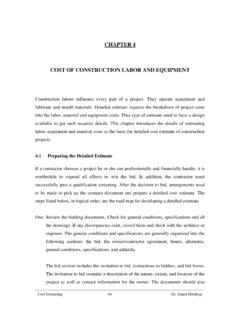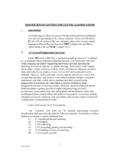Transcription of CHAPTER 8 TRADITIONAL SHOP DRAWING LIABILITY AND …
1 CHAPTER8 TRADITIONAL SHOP DRAWINGLIABILITY AND LIABILITY THATARISES FROM SHARED ORDELEGATED DESIGND ennis J. Powers TRADITIONAL Shop DRAWING LIABILITY [A] Introduction[B] Shop drawings Defined in Standard Form Contracts[C] TRADITIONAL Shop DRAWING LIABILITY [D] Coordination and Review of Shop drawings [1] contractor LIABILITY [2] Designer LIABILITY [E] LIABILITY Arising from the Failure to Timely Reviewand Approve Shop drawings LIABILITY Arising from the Shop DRAWING Process in a Sharedor Delegated Design System[A] Introduction[B] Shop DRAWING Instruction in Shared Design Contracts[C] State Regulation of Delegated Design Responsibility Conclusion8-1 TRADITIONAL SHOP DRAWING LIABILITY [A]
2 IntroductionThis CHAPTER analyzes LIABILITY that arises from the preparation and review ofshop drawings in the TRADITIONAL shop DRAWING review process. In addition, thischapter discusses LIABILITY that may arise from the shop DRAWING process in thenontraditional shared and delegated design drawings have different purposes depending on the project. Any sub-mittal may be considered a shop DRAWING even though a particular submittal sat-isfies only an administrative obligation to supply training manuals or progressschedules. For purposes of this CHAPTER , the term shop DRAWING generally refersto a supplier s, specialty contractor s, or fabricator s detailed depiction of infor-mation shown in the plans and specifications that explains or illustrates fabrica-tion and installation.
3 Such shop drawings are typically not prepared by theprimary design professional. Rather, they are prepared in the chain of contractorsand suppliers; and thus, they typically include not only an illustration of the fab-rication and installation details for a particular component or system of a build-ing, but also an indication of the coordination of that component with otherbuilding components to ensure constructability in the definition, the shop DRAWING process represents a basic form of del-egated design. The shop DRAWING process involves suppliers and contractors in thedesign process by requiring them to design the individual components of theproject for which they are responsible.
4 In designing a building, a design profes-sional simply cannot design every detail of every component and system. It wouldbe a monumental task for the project architect to design every connection and theinteraction of every component and the shop DRAWING process, for instance, the steel fabricator provides shopdrawings that identify each piece of steel , and how and where the pieces connectto each other. Moreover, the HVAC contractor often provides shop drawings thatshow the location of all duct work that it will install. A project architect cannot beexpected to design down to this level of detail. Not only would the cost to theowner be prohibitive, but most architects do not possess the expertise to providesuch a level of detailed design.
5 Thus, it is not always in the owner s best interestto require the architect to furnish an ultimate or complete design. The ownerwould likely run into delays caused by constructability issues and perhaps morefrequently discover design also sometimes design a component or system by merely iden-tifying what the component should look like and its performance example, an architect s design of a curtain wall system may show the wall sappearance and specify the wind loads and lateral resistance requirements, but thearchitect will leave the design of the curtain wall, specifically the means of attach-ment and dimensions, to the curtain wall subcontractor who likely has greaterexpertise in the design of such SHOP DRAWING LIABILITY [A]
6 8-3 Shop drawings provide the architect and contractor the opportunity to reviewand approve what the supplier or subcontractor intends to supply and constructbefore it proceeds with fabrication or construction. In the TRADITIONAL design-bid-build project delivery system, the contractor reviews the shop drawings providedby subcontractors and suppliers to ensure that the subcontractor and supplierintends to supply work and material consistent with the contract , the architect reviews the shop drawings to ensure that the building com-ponent or system that the supplier or subcontractor intends to supply or install isconsistent with the architect s intent or design concept for the structure.
7 [B] Shop drawings Defined in Standard Form ContractsThe American Institute of Architects (AIA) defines shop drawings as:[D]rawings, diagrams, schedules and other data specially prepared for theWork by the contractor or a Subcontractor, Sub-subcontractor, manufacturer,supplier or distributor to illustrate some portion of the AIA A201 General Conditions suggest that the purpose of submittingshop drawings is to demonstrate the way by which the contractor proposes toconform to the information given and the design concept expressed in the Con-tract Documents for those portions of the Work for which the Contract Docu-ments require submittals.
8 2In other words, shop drawings illustrate how thecontractor intends to implement the architect s the AIA provides separate definitions, the term Shop drawings may be interpreted to subsume Product Data and Samples. 3 The term Prod-uct Data is defined as illustrations, standard schedules, performance charts,instructions, brochures, diagrams and other information furnished by the Con-tractor to illustrate materials or equipment for some portion of the Work. Theterm Samples is defined as physical examples that illustrate materials, equip-ment or workmanship and establish standards by which the Work will be judged. For either term, an illustration may constitute a DRAWING prepared for the work,which in turn is encompassed by the term Shop drawings .
9 For instance, the AIA suggests that shop drawings should not includereprinted manufacturer diagrams. Such diagrams, however, arguably fall underthe definition of product data, which in turn arguably falls under the definition ofshop drawings . Such contradictory suggestions or ambiguities provide sufficientreason for contractors to be aware of LIABILITY for manufacturer diagrams as shopdrawings. Since such diagrams would likely be deemed shop drawings morereadily than contract documents, the AIA seemingly gives the owner the right topursue the contractor or the manufacturer for product General Conditions of the Contract for Construction (2007 ed.)
10 2 AIA Document A201, General Conditions of the Contract for Construction (2007 ed.).3 AIA Document A201, General Conditions of the Contract for Construction [B]SHARED DESIGN8-4 The AIA attempts to make it clear that shop drawings , product data, andsamples are not considered part of the contract documents. The AIA likelyexcludes these submittals from the contract documents because the owner typi-cally does not have the opportunity to review specialty designs. Thus when sub-mittals are sent to the architect, they cannot represent the mutual agreement of thearchitect and owner to the same degree as the contract drawings are defined by the Engineers Joint Contract DocumentsCommittee General Conditions of Construction as.










